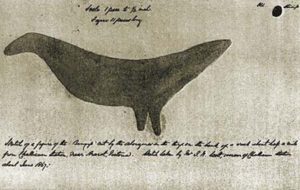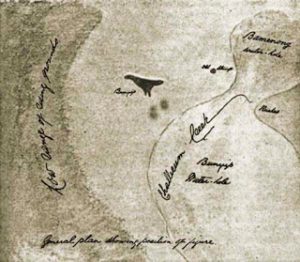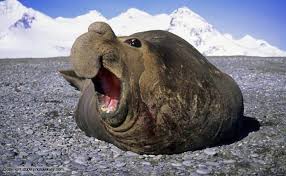Podcast: Play in new window | Download (Duration: 20:30 — 21.7MB)
Part two of the Bigfoot episode sort of got away from me. We start with giants of Patagonia and end up, inexplicably, with seals in Australia. But it’s a fun ride along the way, where we learn about real giants in Patagonia, folkloric giants in Patagonia, the Yowie of Australia, and the Bunyip of Australia. And Southern elephant seals.
Some map giants:

Yowie candy, because it’s getting close to Halloween:

A drawing of the bunyip geoglyph:

A map showing where the geoglyph was located. Old maps are neat:

The southern elephant seal. Look at that magnificent snoot!

Further reading:
Monsters of Patagonia by Austin Whittall
“What to make of the Yowie?” By Darren Naish
“Buckley’s Bunyip” by Paul Michael Donovan, in The Journal of Cryptozoology, Vol. 4 (Dec 2016)
Further listening:
The Folklore Podcast December 15 2016 episode “Bunyip: Devil of the Riverbed”
Show transcript:
Welcome to Strange Animals Podcast. I’m your host, Kate Shaw.
We’re one week closer to Halloween and deep in monster lore. Last week we learned about the Yeti. This week we’re going to learn about bigfoot-type legends from other parts of the world—specifically, Patagonia and Australia.
Patagonia isn’t a country but a region at the southern tip of South America. Part of it is in Chile, part in Argentina. It includes the Andes Mountains, and the southern end is only 600 miles from Antarctica. People have lived in the area for at least 13,000 years and there are many different indigenous cultures still living there today.
Much of South America was originally populated by the little-known Clovis People, who migrated into the Americas from Asia once the glaciers retreated from Alaska. The Clovis People are supposed to have arrived around 13,000 years ago, but archaeologists have dated some non-Clovis sites in both North and South America to much earlier than that. One theory is that an earlier human migration reached South America by sea from the South Pacific, although this is controversial. DNA studies of First Nations people suggest that there may have been an earlier migration from Asia into North America, possibly 20,000 years ago, before the Clovis People arrived.
The first Europeans to visit Patagonia were Magellan and his crew on their voyage around the world. They spent the winter in Patagonia in 1520, and Magellan is the one who named the area. Specifically, he named its people Patagons, and reported that they were giants.
Antonio Pigafetta was one of only 18 survivors of the expedition. When he got home, he wrote about his adventures. He described the Patagons as nine to twelve feet tall, or 2 and three-quarters to over 3 and a half meters tall.
Soon everyone in Europe knew Patagonia was the land of giants. Maps of the region included illustrations of bearded men nearly twice as tall as the explorers greeting them. It would be easy to dismiss the accounts of giants as inventions to sell a few books, except that other explorers were reporting the same thing.
A priest from a Spanish expedition reported that in 1525 he saw native men who were 13 spans tall, or 9 feet, or 2.75 meters. In 1577 Sir Francis Drake visited Patagonia, and later his chaplain reported seeing giants 5 cubits tall, or 7 ½ feet, or 2.3 meters. In 1579 another Spanish expedition started a short-lived settlement in the Strait of Magellan, which ended up being renamed Port Famine, and maybe they wouldn’t have starved if they hadn’t started off by killing one of the giant locals. According to the expedition leader, Pedro Sarmiento de Gamboa, it took ten men to capture the native. Only one settler survived the bitter winters and lack of provisions. He was rescued by an Englishman, Sir Thomas Cavendish, who didn’t see any giants but did see footprints he reported as 18” long, or almost 46 centimeters.
The reports of giants continued, in 1591, 1599, 1614, 1641, and so on well into the 18th century. In 1615 two men dug up some stone cairns and underneath found human skeletons they said were ten or eleven feet long, or a bit over 3 meters. In 1642 Dutch admiral Henry Brewer reported more 18” footsteps in Tierra del Fuego.
All this sounds definitive. But other expeditions didn’t report seeing giants, including those from 1535, 1540, a land exploration from 1557 to 1559, 1618, another land expedition from 1623 to 1624, 1670, and so on. Tellingly, after a 1741 shipwreck on the southern Chilean coast, a survivor, John Bulkeley, claimed he encountered gigantic men in the area—but Thomas Pascoe, a member of the same fleet, disagreed. He said the people in the area were average-sized—and, incidentally, not wild cannibals as Bulkeley claimed. Pascoe called them “harmless, civil, and inoffensive.”
So what’s going on? Are all these people, hundreds of sailors, soldiers, priests, and even naturalists, from different eras and nations, all liars?
In 1767, Captain Samuel Wallis, apparently fed up with the conflicting reports about giants, sailed to Patagonia with a measuring rod. There he measured some very tall people, for sure, but not giants. The tallest man he measured was 6 feet 7 inches, or 2.01 meters, with several others only an inch or two shorter. But, he reported, most were between 5 feet 10 inches and six feet tall, or 1.78 to 1.83 meters. And their feet, he mentioned, were quite small.
Several subsequent European measuring expeditions revealed the same proportions among the Tehuelche, a large and varied group of nomadic people who lived throughout Patagonia. The Tehuelche were among the tallest people in the world. Since the average height of a northern European in the 16th century was 5’ 6” or 1.67 meters, and the average height of a southern European was only 5 feet or 1.5 meters, a group of people whose average height was 6’1” or 1.86 meters would seem like giants. The rest was likely due to exaggeration.
The Tehuelche were almost completely destroyed in the late 19th century, and those who survived warfare and introduced diseases were mostly absorbed into other groups. Only about 6,000 Tehuelche remain scattered across South America.
But were the Tehuelche the only so-called giants in Patagonia? Various Europeans reported another group called the Tiremenen or the Caucauhue, who were not just tall, but stout and muscular mountain people last seen around the 1700s. They were supposedly bigger than the Tehuelche, warlike and dangerous. According to various stories, the Tehuelche finally killed the last of them after a fierce battle. Survivors of the battle took refuge in a cave, where the Tehuelche lit fires and asphyxiated them with thick smoke.
So far, all these giants are people, not furry Bigfoots. But there are plenty of stories from various indigenous groups of wild men and monsters in Patagonia, especially in the forests and mountains. According to the Alakuf, the Mwono was a snow man that lived among the glaciers and high mountains and left tracks in the snow. Over a thousand miles north, or 2,000 km, the Mapuche told a similar story. The Carcancho were hairy solitary men who lived in the mountains. They could stand almost 7 feet tall, or over 2 meters, and left large footprints in the snow. The Mapuche also believed that a giant with fiery red hair and beard, called a Trauko, lived along the Collón Curá River.
While the Mapuche people have lived in what is now Chile and Argentina for some 2500 years, they differ genetically from other indigenous peoples of Patagonia. When they moved into Patagonia, they conquered and absorbed many other tribes, and it’s possible many of their stories of the olden days come from those tribes. They say that giant animals once lived in the area but that their ancestors killed most of them, along with the evil giants that once lived there too. It’s hard not to speculate that the giant animals were megafauna like giant ground sloths. But all the people who migrated to the Americas were humans—no Neandertals or other of our relations made it there as far as we know—and until humans arrived, there were no members of the ape family in the Americas.
So what about other primates? Researchers aren’t sure how monkeys made it to South America, but they’ve been there for some 37 million years. They lived first in the Amazon basin and spread slowly throughout South and Central America. But there are no species of monkey in Patagonia and there hasn’t been for millions of years. The few species of monkey that had spread into Patagonia had already gone extinct long before our first human ancestor started walking upright, so it’s not likely that the first human settlers of Patagonia encountered monkeys. Of course, you never know what fossils might come to light in the future, and there are scattered stories about tribes of men with tails in Patagonia.
In his marvelous book The Monsters of Patagonia, author Austin Whittall suggests that the Patagonian wild man legends, as well as other story elements, may be connected to Australian Aboriginal legends. If the original settlers of Patagonia did arrive by sea from Austronesia, which is by no means established, they would have adapted their stories to their new home. Whittall also suggests that one story in particular may be related to Homo erectus, our direct human ancestor who probably went extinct when humans began competing with them for resources. The ancestors of the Australian Aborigines probably did encounter Homo erectus. Maybe that was the source of the Yowie legend.
I probably don’t need to point out that this is fringey, fringey stuff. But it’s fun to think about.
The Yowie in Australian Aboriginal lore is a man-like monster that’s seven or even as much as 12 feet tall, or around 2 to 3 and a half meters. It has big feet, although some stories say its feet are backwards so people tracking it are actually going the wrong way. Sometimes the Yowie is said to have long white hair. Modern interpretations of the Yowie are a lot like the Sasquatch, with brown or reddish hair all over and arms that hang to its knees.
Many older accounts by European settlers refer to this creature by various other names, including wood devil, Australian gorilla, and Yahoo. I don’t know if Yahoo was an attempt at pronouncing an unfamiliar Aboriginal word or if 19th century pop culture was still drawing on Swift’s Gulliver’s Travels. In Swift’s story, yahoos are brutish but human-like creatures much despised by the narrator, who prefers the company of the intelligent horses that treat the yahoos as servants. Oh, the satire was subtle back in 1726.
These days, the Yowie is as firmly entrenched in Australian culture as Sasquatch is in North American culture. Yowies sell chocolates and toys, appear in cartoons, and like Sasquatch hunters, Yowie hunters run around in the Australian bush and make plaster casts of big footprints.
Let me tell you something important about plaster. It’s a terrible way to make casts of footprints or anything else. Not only does it produce tiny ridges along its edges as it dries, which have been interpreted as dermal ridges of bigfoot feet, it also generates heat as it dries, which has the potential to alter the prints it’s supposed to be faithfully representing. These days, field scientists use dental stone or latex to take casts. Plaster is cheap and readily available, but that doesn’t mean it’s the best.
Anyway, the earliest colonial reports of the Yowie are from around the early 19th century. European settlers sometimes treated the Yowie as a real animal that had yet to be discovered, sometimes as an amusing Aboriginal superstition. Reported Yowie sightings were relatively uncommon until the 1970s. At that point, cryptozoologist Rex Gilroy, whom I disparaged in episode 32 for being secretive about his findings and data, started showing up in the Australian media with big plaster casts of what he claimed were Yowie tracks.
The problem with the Yowie is that Australia, even less so than Patagonia, has never been home to any animal that stands upright the way humans do. Most of Australia’s large mammals are marsupials so they aren’t even remotely related to apes.
It’s possible that the Aboriginal tales of the Yowie are old, old memories of Homo erectus or other human relatives, as I suggested about the Patagonian wild men. But it’s also possible that the Yowie is a monster of human imagination. Cultures from around the world have stories of big people and little people who sometimes help, sometimes cause mischief, or are sometimes just plain menacing. It seems to be a human trait to people the landscape with giants and dwarves.
The more research I do about any cryptid, as opposed to animals we know exist or used to exist, the more I realize cryptozoology is actually about people. It’s the study not so much of unknown animals, it’s the study of how humans interact with the unknown. Sometimes I’m disappointed when I trace a fascinating story back to its primary source and discover it’s not as mysterious as later versions of the event make it out to be. But sometimes I come across something so purely human that I don’t even care that the mystery has evaporated.
So let me tell you about the Bunyip. This is another Australian monster, one that sometimes gets confused with the Yowie in popular culture, or sometimes gets lumped in with lake monsters. I learned about this from an article by Paul Michael Donovan in the 2016 Journal of Cryptozoology, called “Buckley’s Bunyip.” Shortly after I read the article, I happened to listen to the “Bunyip: Devil of the Riverbed” episode of the Folklore Podcast. That episode was an interview with none other than Paul Michael Donovan about the same material his article covered, so if you want more information, check the show notes for a link to that episode.
The bunyip is supposed to be a monster that attacks and eats people who come too near the waterholes or lagoons where it lives. Descriptions vary, but it’s sometimes said to be gray and covered with feathers, with a peculiar two-tone bellow that it uses to warn people away. By about the 1850s the word bunyip had been adopted into Australian English as a term meaning something like humbug or poser.
There was an Aboriginal sacred site near Ararat, Victoria where the outline of a bunyip was carved into the ground and the turf removed from within the figure. Every year the local indigenous people would gather to re-carve the figure so it wouldn’t become overgrown, because it symbolized an important event. At that spot, two brothers had been attacked by a bunyip. It killed one of the men and the other speared the bunyip and killed it. When he brought his family and others back to retrieve his brother’s body, they traced around the bunyip.
The bunyip carving is long gone, since eventually the last Aborigine who was part of the ritual died sometime in the 1850s and the site was fenced off for cattle grazing. But we have a drawing of the geoglyph from 1867. A copy of it is in the show notes. It’s generally taken to be a two-legged sea serpent type monster with a small head and a relatively short, thick tail. Some people think it represents a bird like an emu.
But if you turn it around, with the small head being the end of a tail, and the blunt tail being a head, suddenly it makes sense. It’s the shape of a seal.
The Southern elephant seal lives around the Antarctic, but it is a rare visitor to Australia. It’s also enormous, twice the size of a walrus, six or seven times heavier than a Polar bear. The males can grow over 20 feet long, or over six meters, while females are typically about half that length. The male also has an inflatable proboscis with which it makes horrible roaring sounds. This is a clip of what it sounds like, although these calls are from Northern elephant seals, which are much smaller than Southern elephant seals. Still pretty darn big, though.
[seals honking]
The elephant seal is also an aggressive carnivore. If an elephant seal strayed inland up a river or stream, which does sometimes happen, the Aboriginal people of the area would definitely take notice of the monster.
So the bunyip is, in the end, a true monster. And the bunyip’s story is a deeply human one. A man’s brother died. His family mourned, and commemorated the event with a carving that withstood who knows how many years. Oh, and the carving’s size? It was about eight meters long. That’s 26 feet.
I’m not entirely sure how I ended up talking about seals when we started out talking about giants of Patagonia. But hey, the southern elephant seal lives in Patagonia too.
I could easily do two or three more episodes about bigfoots around the world, but I’m ready for something else. Next week we’ll learn about a four-footed monster from Ireland, a Halloween story if I ever heard one since it starts with a gravestone.
You can find Strange Animals Podcast online at strangeanimalspodcast.com. We’re on Twitter at strangebeasties and have a facebook page at facebook.com/strangeanimalspodcast. If you have questions, comments, or suggestions for future episodes, email us at strangeanimalspodcast@gmail.com. If you like the podcast and want to help us out, leave us a rating and review on iTunes or whatever platform you listen on. We also have a Patreon if you’d like to support us that way. Rewards include stickers and twice-monthly bonus episodes.
Thanks for listening!